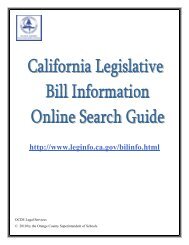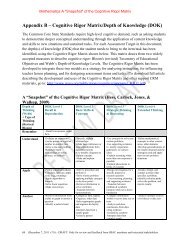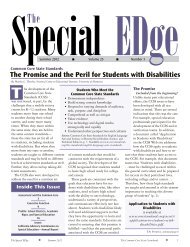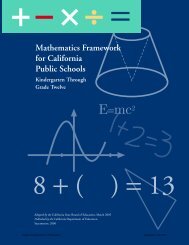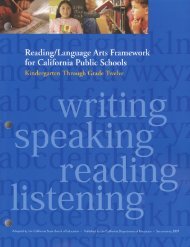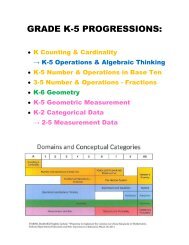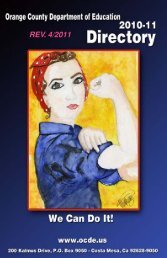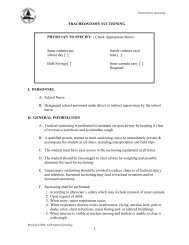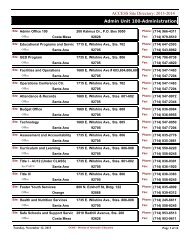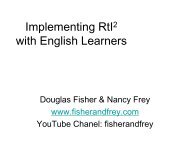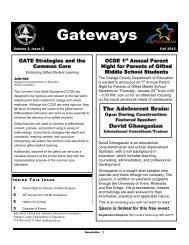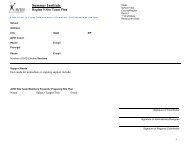Writing Frames for the Annotated Bibliography
Writing Frames for the Annotated Bibliography
Writing Frames for the Annotated Bibliography
Create successful ePaper yourself
Turn your PDF publications into a flip-book with our unique Google optimized e-Paper software.
<strong>Writing</strong> <strong>Frames</strong> <strong>for</strong> <strong>the</strong> <strong>Annotated</strong> <strong>Bibliography</strong><br />
To summarize a source<br />
This primary/secondary source discusses _____________First, <strong>the</strong> author<br />
points out__________________________________In addition, s/he<br />
emphasizes______________________________________. Finally,<br />
(author’s last name) _______________ concludes that<br />
________________. This helped me understand my topic because<br />
_______________.<br />
To show connection to <strong>the</strong> <strong>the</strong>me<br />
This primary/secondary source relates to <strong>the</strong> <strong>the</strong>me (insert <strong>the</strong>me)<br />
___________________ in several ways. First, it relates to <strong>the</strong> <strong>the</strong>me<br />
because _____________________________. Also,<br />
_________________________________. Lastly, it relates to <strong>the</strong> <strong>the</strong>me<br />
because _________________________________. Overall,<br />
___________________________________________.<br />
To discuss <strong>the</strong> value of a source<br />
In this source, I learned _________________________. One of <strong>the</strong> most<br />
valuable pieces of in<strong>for</strong>mation I read/saw was _______________ because<br />
________________________. It helped me with my research because<br />
_________________________. The most thought provoking thing <strong>the</strong><br />
author mentioned was _______________________ because<br />
_______________________. In conclusion, ______________________.<br />
To explain how you will use this source in your Project<br />
This source was about ________________________________. I plan to use<br />
this in my project by __________________________. Also, it will help with<br />
my project because ____________________________. There<strong>for</strong>e,<br />
_______________________________.
To explain why it is categorized as a primary source (Only use this if you<br />
think it will be questioned!)<br />
This source is listed as a primary source because ___________________.<br />
One of <strong>the</strong> most interesting primary sources I used was _______________,<br />
which was about __________________________. Interestingly, <strong>the</strong> source<br />
also ________________________________________. To summarize,<br />
_______________________________.<br />
To show <strong>the</strong> different arguments surrounding your topic.<br />
This primary/secondary source helped me see different points of view. My<br />
topic, __________________ is very controversial. On one hand, <strong>the</strong> author<br />
discussed_______________________. However, ano<strong>the</strong>r perspective that<br />
was pointed out was ____________________________. In conclusion,<br />
____________________.
Name _________________________________________________________ Period ________<br />
Title of source: ______________________________________________________<br />
Type of source (book, video, website, etc) _______________________<br />
_____ Primary source<br />
_____ Secondary source<br />
Use www.citationmachine.net or http://www.easybib.com to create a citation <strong>for</strong> your<br />
source. Make sure to indent all lines after <strong>the</strong> first line.<br />
First read: write a 25-word GIST about what you read/saw<br />
Second read: write five new facts that you learned from this source
Third read: Find 3 pieces of textual evidence that show how what you read helps you<br />
understand how your topic relates to <strong>the</strong> <strong>the</strong>me, is significant in history, or changed<br />
history<br />
Textual evidence (put in quotes)<br />
Analysis (so what??)<br />
Textual evidence (put in quotes)<br />
Analysis (so what??)<br />
Textual evidence (put in quotes)<br />
Analysis (so what??)
Rubric <strong>for</strong> Sources<br />
Name _____________________________________________________________________<br />
All sources must be fully documented using <strong>the</strong> note-taking documentation <strong>for</strong>ms. In addition all<br />
sources must be documented onto a Works Cited page. Hand in this rubric along with attached<br />
notes on ____________________<br />
A Grade B Grade C Grade Notes<br />
6 sources<br />
Must have at least<br />
1 book<br />
3 websites<br />
1 movie<br />
TWO of <strong>the</strong> sources<br />
need to be primary<br />
sources<br />
1 source needs to<br />
be from <strong>the</strong> “O<strong>the</strong>r<br />
Category”<br />
6 sources<br />
Must have at least<br />
1 books<br />
3 websites<br />
1 movie<br />
ONE of <strong>the</strong> sources<br />
needs to be primary<br />
sources<br />
1 source needs to<br />
be from <strong>the</strong> “O<strong>the</strong>r<br />
Category”<br />
5 sources<br />
Must have at least<br />
1 book<br />
2 websites<br />
1 movie<br />
One of <strong>the</strong> sources<br />
needs to be a<br />
primary source<br />
O<strong>the</strong>r possible sources could include museum visits, interviews, pictures, magazine articles,<br />
pamphlets, brochures, fliers, newspaper articles, reference books/encyclopedias.
Rubric <strong>for</strong> Sources<br />
COUNTY COMPETIVE<br />
All sources must be fully documented using <strong>the</strong> note-taking documentation <strong>for</strong>ms. In addition all sources must<br />
be documented onto a Works Cited page.<br />
A+ Grade A Grade B Grade C Grade Notes<br />
17 or more sources<br />
Must have at least<br />
1 book<br />
1 website<br />
1 movie<br />
Four of <strong>the</strong> sources<br />
need to be primary<br />
sources<br />
16 sources<br />
Must have at least<br />
1 book<br />
1 website<br />
1 movie<br />
Three of <strong>the</strong> sources<br />
need to be primary<br />
sources<br />
9 sources<br />
Must have at least<br />
1 book<br />
1 website<br />
1 movie<br />
Two of <strong>the</strong> sources<br />
needs to be primary<br />
sources<br />
5 sources<br />
Must have at least<br />
1 book<br />
1 website<br />
1 movie<br />
One of <strong>the</strong> sources<br />
needs to be a primary<br />
source<br />
O<strong>the</strong>r possible sources could include museum visits, interviews, pictures, magazine articles, pamphlets,<br />
brochures, fliers, newspaper articles, reference books/encyclopedias.
READING<br />
Vista del Mar<br />
Middle School<br />
Social Science/History<br />
Students will read, interact with, and respond to a<br />
variety of historical genres, including primary and<br />
secondary sources.<br />
READING SKILLS<br />
• Cite textual evidence<br />
• Determine <strong>the</strong> central ideas or in<strong>for</strong>mation<br />
• Provide an accurate summary<br />
• Identify key steps in a text’s description of a<br />
process<br />
• Determine <strong>the</strong> meaning of words and phrases<br />
as <strong>the</strong>y are used in a text (context clues)<br />
• Describe how a text presents in<strong>for</strong>mation<br />
• Explain and identify author’s point of view<br />
• Integrate visual in<strong>for</strong>mation with o<strong>the</strong>r<br />
in<strong>for</strong>mation<br />
• Distinguish among fact, opinion, and reasoned<br />
judgment<br />
• Analyze <strong>the</strong> relationship between a primary<br />
and secondary source on <strong>the</strong> same topic<br />
• Read multiple texts on same topic<br />
• Read text <strong>for</strong> in<strong>for</strong>mation and successfully pull<br />
out key details from <strong>the</strong> written passages<br />
• Connect and clarify main ideas<br />
• Determine author’s conclusions<br />
• Analyze text using compare/contrast patterns<br />
• Compare and contrast text in different <strong>for</strong>ms<br />
VOCABULARY<br />
• Content Area Vocabulary<br />
• Context Clues<br />
• Application & Multiple Use<br />
• Categorizing & Discussing<br />
• Roots and Affixes (prefixes & suffixes)<br />
• Vocabulary will be integrated with existing<br />
knowledge<br />
• Repeated exposure will provide ample<br />
opportunity <strong>for</strong> meaningful use<br />
WRITING<br />
• Use technology, including <strong>the</strong> Internet, to<br />
produce and publish writing and to interact and<br />
collaborate with o<strong>the</strong>rs<br />
• Argue to support claims with clear reasons<br />
and relevant evidence<br />
• Write in<strong>for</strong>mative/explanatory texts to<br />
examine a topic and convey ideas, concepts,<br />
and in<strong>for</strong>mation through <strong>the</strong> selection,<br />
organization, and analysis of relevant content<br />
• Write narratives to develop real or imagined<br />
experiences or events using effective<br />
technique, relevant descriptive details, and<br />
well-structured event sequences<br />
THE PROCESS<br />
• Develop and streng<strong>the</strong>n writing as needed by<br />
planning, revising, editing, rewriting, or trying<br />
a new approach.<br />
LISTENING/SPEAKING<br />
SPEAKING<br />
• Engage effectively in a range of<br />
collaborative discussions (one-on-one, in<br />
groups, and teacher-led) with diverse<br />
partners on grade level topics<br />
• Present claims and findings<br />
• Include multimedia components (e.g.,<br />
graphics, images, music, sound) and visual<br />
displays in presentations to clarify<br />
in<strong>for</strong>mation<br />
• Adapt speech to a variety of contexts and<br />
tasks.<br />
SKILLS<br />
• Successfully read text <strong>for</strong> in<strong>for</strong>mation and pull<br />
out key details from <strong>the</strong> written passages<br />
• Note Taking: Cornell, Outlines, Study Guides,<br />
Highlighting, Graphic Organizers,<br />
Summarizing, Visualization, Illustrated Notes,<br />
Bullet Notes<br />
• Working cooperatively with peers
• Reading multiple texts in regards to each unit<br />
• Determine credibility of sources<br />
• Determine key concepts<br />
• Interpret and evaluate evidence<br />
• Draw conclusions<br />
• Determine facts / opinions / reasoned judgments<br />
RESEARCH<br />
• Students will participate in a long- term<br />
research project<br />
• Conduct research project based on focused<br />
questions, demonstrating understanding of <strong>the</strong><br />
subject under investigation<br />
• Ga<strong>the</strong>r relevant in<strong>for</strong>mation from multiple print<br />
and digital sources, assess <strong>the</strong> credibility and<br />
accuracy of each source, and integrate <strong>the</strong><br />
in<strong>for</strong>mation while avoiding plagiarism<br />
• Draw evidence from literary or in<strong>for</strong>mational<br />
texts to support analysis, reflection, and<br />
research<br />
Research Timeline<br />
September/October<br />
• Introduction to primary and secondary<br />
sources<br />
• Historical interpretation and document<br />
analysis<br />
• Select topic and begin to narrow focus<br />
• Write a working <strong>the</strong>sis statement<br />
• Bibliographies and annotations<br />
• Credibility of sources<br />
• Note taking and paraphrasing<br />
November/December<br />
• Project essentials<br />
• Individual conferences<br />
• Construction of presentation<br />
• Formal presentation practice<br />
• Projects due 12/19/13<br />
January<br />
• Oral presentations of projects<br />
• Ga<strong>the</strong>r relevant in<strong>for</strong>mation from multiple print<br />
and digital sources<br />
• Use libraries, museums, interviews, credible<br />
websites, and documentaries<br />
• Use <strong>the</strong> <strong>the</strong>me Rights and Responsiblities <strong>for</strong><br />
<strong>the</strong>ir research<br />
Three Research Goals<br />
1- To choose a topic of interest to <strong>the</strong> student<br />
2- To learn how to conduct research and think critically<br />
3- To manage time <strong>for</strong> a long-term project
Research Log<br />
Students should be working on <strong>the</strong>ir research 15 minutes a school night OR 60-70 minutes a week. On your log, keep<br />
track of when you search, what you accomplished, what you learned.<br />
Name _________________________________________________________________________________________________<br />
Topic ________________________________________________________________________________<br />
Working Thesis Statement<br />
____________________________________________________________________________________________<br />
__________________________________________________________________________________________________________________<br />
__________________________________________________________________________________________________________________<br />
__________________________________________________________________________________________________________________<br />
Date Task Completed Time Spent Parent Signature<br />
__________ _________________________________________________ __________ _________________________<br />
__________ _________________________________________________ __________ _________________________<br />
__________ _________________________________________________ __________ _________________________<br />
__________ _________________________________________________ __________ _________________________<br />
__________ _________________________________________________ __________ _________________________<br />
__________ _________________________________________________ __________ _________________________<br />
Total time spent this week _________<br />
Weekly Reflection (4-6 sentences that discuss your progress, achievements, struggles or questions <strong>for</strong> teacher)<br />
___________________________________________________________________________________________________________________<br />
___________________________________________________________________________________________________________________<br />
___________________________________________________________________________________________________________________<br />
___________________________________________________________________________________________________________________<br />
___________________________________________________________________________________________________________________<br />
___________________________________________________________________________________________________________________<br />
___________________________________________________________________________________________________________________<br />
___________________________________________________________________________________________________________________<br />
___________________________________________________________________________________________________________________




